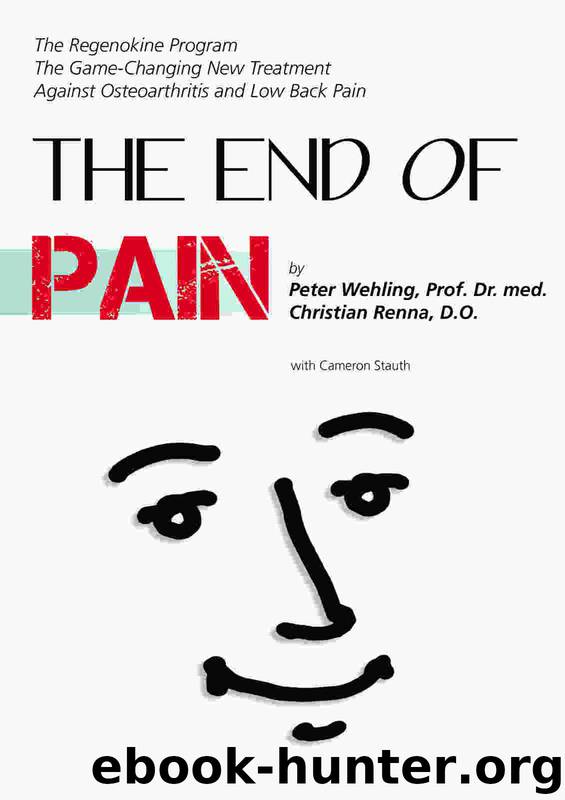The End of Pain- by Wehling Dr. Peter & Renna Dr. Chris

Author:Wehling, Dr. Peter & Renna, Dr. Chris [Wehling, Dr. Peter]
Language: eng
Format: mobi
Publisher: Amazon.de
Published: 2011-08-03T16:00:00+00:00
Element #2: Sufficient Exercise
Movement is one of the most problematic parts of the program, because it is not only necessary for recovering from arthritis, but is also one of the aspects of health that is most compromised by arthritis. Once again, we see the interlocked cage of cause/symptom/cause that holds so many people captive.
Nonetheless, this cycle can be broken, and it all begins with simple, fundamental movement.
Movement is generally characterized, by most physicians and physical therapists, as exercise, and virtually all doctors now recommend exercise to people with arthritis. I generally prefer to use the term “movement,” though, because it has the wider connotation of recognizing the fact that for someone with arthritis, practically every movement can be of benefit. I have found that when I recommend exercise to my clients, they tend to conjure up images of relatively intense aerobic exercise, or difficult sessions of weight training. Nothing is wrong with a good, hard work out, but strenuous activity is usually not necessary to achieve the goals that most people with arthritis have.
People with arthritis generally have two main goals: to reduce pain, and increase mobility. Both of these goals can be achieved with mild exercise, focused simply around movement.
For many years, doctors thought that a formal program of exercise, or movement, was harmful for people with arthritis. They believed that it would place too much stress on joints that were already damaged by wear and tear. More recently, it’s been accepted that exercise actually improves joint function – which is yet another indication that arthritis is, as Dr. Wehling and I believe, not a wear-and-tear condition, but an inflammatory condition.
Here’s how it helps:
People with arthritis and back pain often tend to avoid exercise, and this can be a devastating mistake. Furthermore, lack of exercise prior to the onset of arthritis can be one of the primary predisposing factors to arthritis and back pain.
I expect the majority of people reading this book will have Osteoarthritis. The majority of those will have some limitation when it comes to exercise but most will be able to do something. If you can walk, do it. If you can’t walk find a place to swim and do that. If you can’t walk or swim, stretch, do knee bends or pushups, chair dips or crunches. If you can’t do any of those, do yoga or Pilates. If you want to exercise, you’ll find a way and if you want to reduce inflammation and help yourself you’ll have to exercise. I hate being circular about this but there is no other way.
Don’t do any exercise that hurts. If it hurts during or afterward, it’s not going to lower inflammation. Using exercise to stay healthy doesn’t require the kind of toughness that enables you to endure pain, it requires discipline and determination. There are a thousand ways to exercise and a million resources ready to tell you how.
People with severe Osteoarthritis, low back pain, or co-morbid condition that make exercising more risky or difficult should begin
Download
This site does not store any files on its server. We only index and link to content provided by other sites. Please contact the content providers to delete copyright contents if any and email us, we'll remove relevant links or contents immediately.
Men In Love by Nancy Friday(4968)
Everything Happens for a Reason by Kate Bowler(4480)
The Immortal Life of Henrietta Lacks by Rebecca Skloot(4263)
Why We Sleep by Matthew Walker(4193)
The Sports Rules Book by Human Kinetics(4079)
Not a Diet Book by James Smith(3156)
The Emperor of All Maladies: A Biography of Cancer by Siddhartha Mukherjee(2934)
Sapiens and Homo Deus by Yuval Noah Harari(2850)
Day by Elie Wiesel(2597)
Angels in America by Tony Kushner(2394)
Endless Forms Most Beautiful by Sean B. Carroll(2353)
A Burst of Light by Audre Lorde(2350)
Hashimoto's Protocol by Izabella Wentz PharmD(2206)
Dirty Genes by Ben Lynch(2163)
Reservoir 13 by Jon McGregor(2149)
And the Band Played On by Randy Shilts(2020)
Wonder by R J Palacio(1990)
The Immune System Recovery Plan by Susan Blum(1971)
Stretching to Stay Young by Jessica Matthews(1947)
